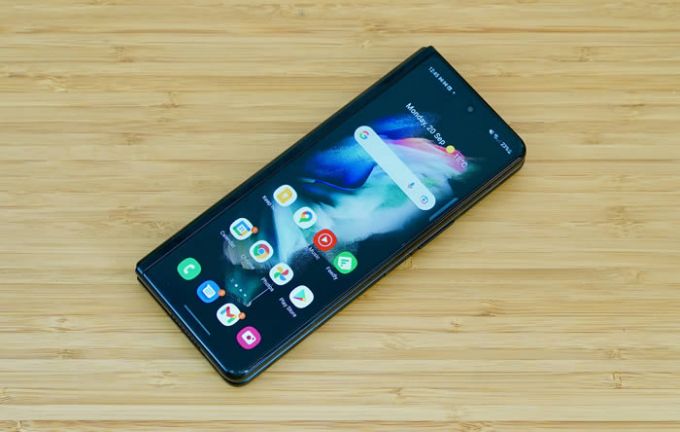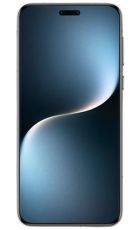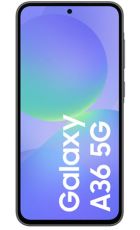The Samsung Galaxy Z Fold 3 is Samsung’s third attempt to make a foldable phone-tablet hybrid, and it’s the company’s most successful effort yet.
Like the two Samsung Galaxy Z Fold devices before it, this is essentially a double-thickness flagship smartphone that unfurls into a slim but fully-featured mini-tablet.
At £1,599, it’s not cheap, and there are one or two compromises you’ll still need to make if you want to live the foldable phone lifestyle. But what those extra costs get you is a phone that can display content in a uniquely expansive manner.
Screen
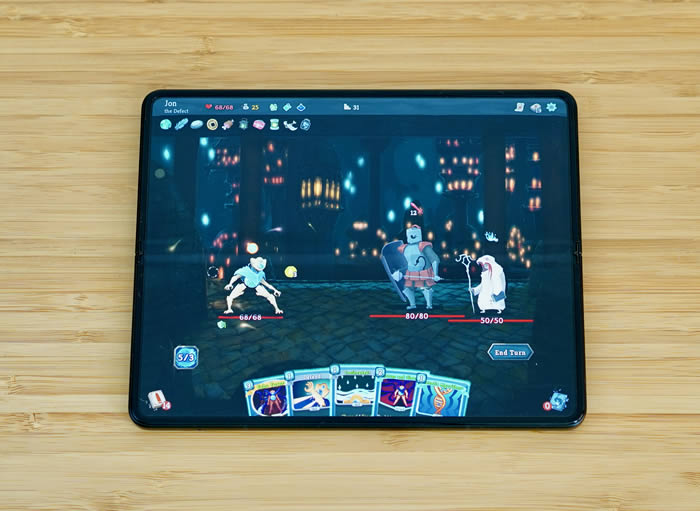
Samsung’s foldable vision involves two displays. The main one is a huge 7.6-inch AMOLED with a 1768 x 2208 resolution and a fluid 120Hz refresh rate.
This display folds out like a book, leaving a noticeable groove along the inner spine. Samsung’s approach means that the display features an almost square aspect ratio more in keeping with a tablet than a smartphone.
The size and shape of this main display makes it great for surfing the web, viewing documents, and editing spreadsheets. It’s not a natural canvas for video content, though, with thick black borders framing the action.
Its value to gaming is more mixed. Playing an action game like CoD Mobile on the display doesn’t feel too natural, but playing a a more strategic title like Slay the Spire or Kingdom Rush feels fabulous.
The Galaxy Z Fold 3’s second display is a more traditional 6.2-inch 816 x 2260 Super AMOLED. It’s located on the outside of the device, and is intended to enable you to use the device as a ‘normal’ phone when it’s closed up.
This time around this second screen matches the main display’s 120Hz refresh rate, meaning it’s extremely fluid in use.
Design
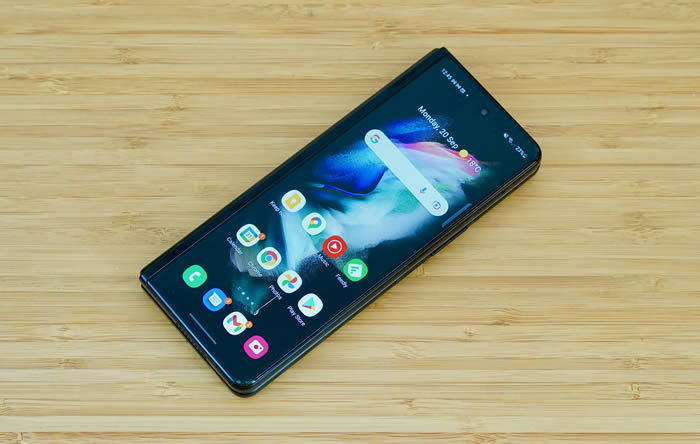
As we’ve already discussed, the design of the Samsung Galaxy Z Fold 3 review 5G sees it folding out like a book into a form factor that’s much larger than even the largest traditional smartphone.
This does mean that this is a rather hefty, unwieldy piece of equipment. It’s very heavy at 271g, which dwarfs even the mighty Xiaomi Mi 11 Ultra on 234g.
When closed up, the Fold 3 might resemble a particularly narrow phone, but it’s still 14.4 to 16mm thick. That’s around double your average flagship phone.
That variation in thickness also reflects the fact that the foldable display doesn’t sit dead flush when closed. There’s a slight gap near the hinge, which feels a little clunky.
What a solid piece of engineering that hinge is, though. It’s weighty and stiff enough to pause at any position, and there’s no wobble or flex. Samsung has even managed to seal the gaps sufficiently to give the device an IPX8 rating, which means that it’s water resistant up to 1.5 metres for 30 minutes.
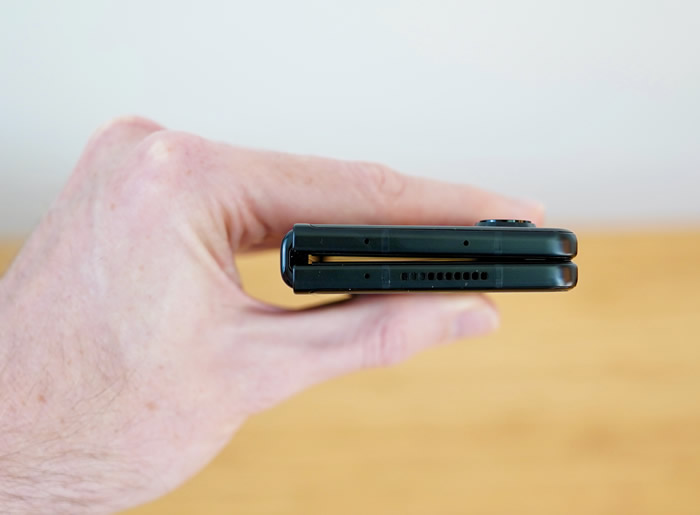
Samsung has gone with a side-mounted fingerprint sensor here, which is incorporated into the power button on the right-hand edge. It works well.
All in all, the Samsung Galaxy Z Fold 3 is the best-built, most impressively durable foldable phone Samsung has built yet. But it’s still not as easy to simply throw into a pocket as a regular flagship phone.
Power
The Samsung Galaxy Z Fold 3 runs on Qualcomm’s Snapdragon 888 processor, which is the go-to chip for a 2021 Android flagship. It’s good to see this being used across the board, rather than the company’s inferior Exynos equivalent, as was the case with the global Samsung Galaxy S21 Ultra model.
Together with an ample 12GB of RAM, you get excellent performance from the Fold 3. Benchmarking tools reveal that it hits parity with fellow flagship phones like the OnePlus 9 Pro and the Oppo Find X3 Pro.
Games run well too, with CoD Mobile playing fluidly on the highest graphical settings - despite the slightly odd square viewpoint.
There’s ample storage, with both 256GB and 512GB options. It’s a shame there’s no microSD slot facility though, which would have made a lot of sense in such an expansive device.
Camera
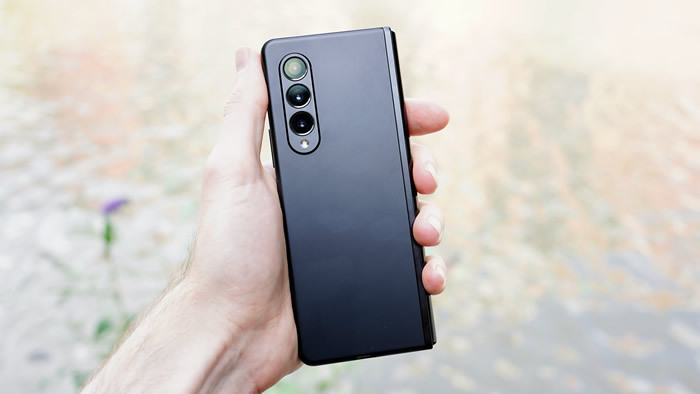
We wouldn’t say that the Samsung Galaxy Z Fold 3’s camera is weak, but it’s certainly not up there with the very best on the market. Which you might well expect if you’re spending £1,600.
With that said, the Galaxy Z Fold 3 takes solid shots in all conditions. It features a trio of 12MP sensors covering wide, ultra-wide, and 2X telephoto. It’s the same basic set-up we got with the Samsung Galaxy Z Fold 2 last year.
Samsung’s colour science is as punchy as ever, while the snaps we captured were bright and reasonably sharp. Even our indoors shots looked good.

Ultimately, though, we expected more. Phones like the Oppo Find X3 Pro, the iPhone 12 Pro Max, and yes, the Samsung Galaxy S21 Ultra, all take better shots and give you more advanced features for less money.
The most impressive thing about the 4MP selfie camera is that it’s almost invisible, sitting underneath the display. When it comes to shot quality, it’s not very good at all.
There’s a superior secondary 10MP selfie camera on the outside of the phone. Really, though, you don’t need either. It’s possible to use that secondary display as a viewfinder, thus turning the main cameras into excellent selfie shooters in their own right.

Features
Samsung’s One UI has long enabled you to run two apps side by side in split-screen, but it makes the most sense with the Fold line. With that huge, square 7.6-inch display, it doesn’t feel at all cramped to check your emails whilst simultaneously browsing the internet in Chrome.
Not everyone is a fan of Samsung’s custom take on Android, but it’s come a long way in recent years. It gets the balance between customisation potential and intuitiveness just about right, though it’s undoubtedly busier than stock Android.
This year’s Fold model finally adds support for Samsung’s S Pen stylus, which always made a lot of sense for such a pocketable tablet. You’ll have to buy it separately, however, and there’s nowhere to stash the stylus in or on the device itself.
That feels like something of a missed opportunity in a year where Samsung has officially ditched its Galaxy Note line.
Battery life, memory and connectivity
The Samsung Galaxy Fold 3 only packs a 4400mAh battery, which feels worryingly small in a phone with a 7.6-inch 120Hz display. While it’s true that it’s not an absolute stamina champion, however, it should get most people through a solid day of usage without worry.
One particularly intensive day of 13 hours 40 minutes, during which we clocked 5 hours and 43 minutes of screen-on time (including several hours of light gaming and web browsing on the main screen), left us with 10% battery life.
A lighter 13 hour day, in which we clocked up 3 hours 30 minutes of screen-on time, left the Galaxy Z Fold 3 with a solid 50% left in the tank.
Samsung still doesn’t include a charging brick in with its phones, so you’ll have to provide your own. Even then, the Fold 3 only supports up to 25W, which isn’t very fast by modern flagship standards. It also supports wireless charging up to 15W.
There are both 256GB and 512GB storage options out there, which should prove ample for your needs. Apple has just broken the 1TB mark with the iPhone 12 Pro, though, so it’ll be interesting to see if Samsung follows suit with the Galaxy Z Fold 4.
5G is supported, as you might expect in a late–2021 flagship phone costing £1,600. Paired with that fold-out display, the Samsung Galaxy Z Fold 3 has become the ultimate park bench/coffee shop web browsing tool.
Conclusion
The Samsung Galaxy Z Fold 3 is a greatly refined and impressively usable foldable device, providing a more robust design than previous models. Meanwhile its external display now matches the huge 7.6-inch main event in terms of 120Hz fluidity.
When surfing the web or conducting dual-app productivity tasks, there’s really no smartphone that can match the Galaxy Z Fold 3 right now. It’s a full-on mini-tablet in your pocket.
This is still a decidedly niche product, though. It’s big and unwieldy, and the camera system is not at a level you might expect from a £1,600 device. Indeed, that cost in itself should probably rule the Galaxy Z Fold 3 out for the majority of people.
If you’re sold on the perks of the foldable concept, though, the Samsung Galaxy Z Fold 3 is its best proponent yet.


